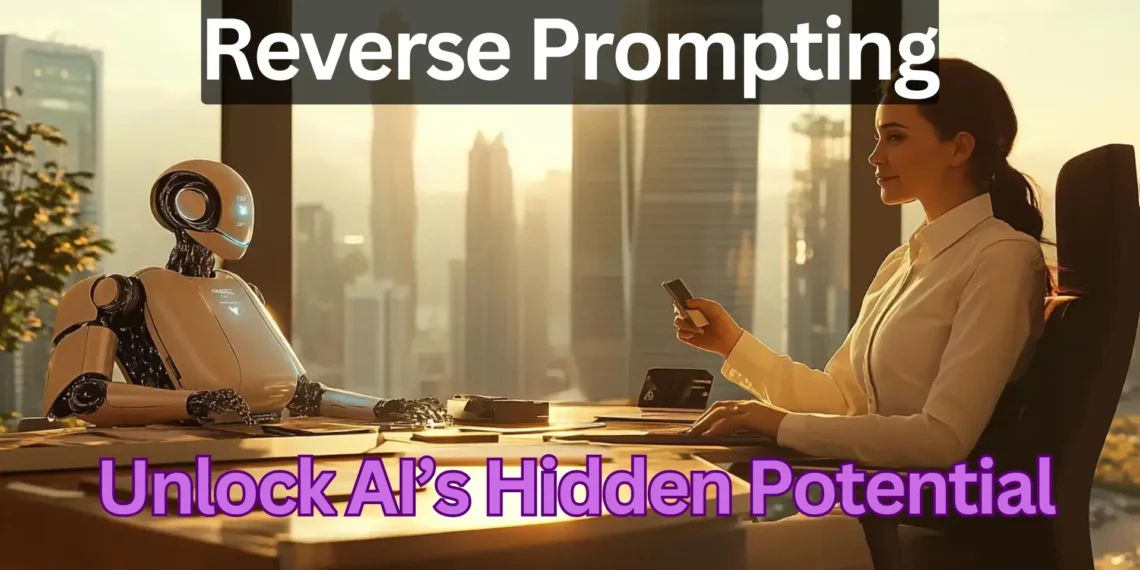Ever thought about making your AI interactions better? Reverse prompting is changing the game by unlocking AI’s true potential. It lets you change how you talk to AI for better results.
By using reverse AI guidance, you can make AI models more responsive and relevant. By focusing on what you want to achieve, reverse prompting improves how you interact with AI. It’s great for marketing, creative writing, and customer service.
Key Takeaways
- Reverse prompting is a revolutionary approach that maximizes AI’s capabilities.
- It provides two fundamental processes: a simple two-step and a more comprehensive multiple-step method.
- Mastering reverse prompting can enhance your content generation across various applications.
- This technique encourages experimentation, allowing for tailored AI interactions.
- Courses like the one available on Udemy offer insights into effective reverse prompt engineering.
Understanding Reverse Prompting
Reverse prompting is a powerful way to improve how we talk to AI systems. It lets users give the AI the end result they want and then figure out the best input. This method makes your prompts much more effective. Knowing what a reverse prompt is helps you use AI better.
What is Reverse Prompting?
Reverse prompting lets users guide AI by focusing on the end result, not just the input. This makes the AI give clearer, more relevant answers. It uses existing data to find important insights, which is really useful in projects.
Many people don’t know about reverse prompting, but it can reveal deep insights. For example, in survey results, it shows why people think certain things.
Importance of Reverse Prompting in AI
Reverse prompting is very important for AI. It helps organizations use AI better by giving specific, relevant answers. This method makes the user experience better and more responsive
| Application Area | Impact of Reverse Prompting |
|---|---|
| Marketing | Enhanced targeting and engagement through precise outcome-based prompts. |
| Creative Writing | Improved story development by focusing on desired narrative outcomes. |
| Customer Service | More relevant and context-aware responses to customer inquiries. |
| Data Analysis | Facilitates deeper insights from existing data and trends. |
The Techniques Behind Reverse Prompting
Learning how to use reverse prompting can make AI work better for you. By getting good at these methods, you can get the most out of tools like ChatGPT 3.5 and Copilot. This leads to answers that are more precise and fit what you need.
Two-Step Reverse Prompting Process
The two-step process starts by setting the context, then giving specific details. First, make an initial prompt that clearly states what you want to achieve. For example, if you’re writing a sales script, list the goals, who you’re talking to, and the main points to cover.
This approach helps get results that are right on target. It’s a way to give clear support to the AI, making sure it understands what you need.
Multiple-Step Reverse Prompting Process
The multiple-step process goes deeper, engaging more with the AI. By making a series of prompts that add to each other, you get answers that are more detailed and rich. This is great for complex tasks, like making educational content or complex marketing plans.
With ChatGPT 3.5, you can explore many ideas and outcomes thanks to its unlimited character limit. This method lets you refine your questions and check the results closely. It helps you understand AI better and boosts creativity and personalization in what you create.
Reverse prompting starts with a clear, directionally accurate prompt that guides where you want to go—something like, “Write me a story,” “Compose an email,” or “I’m a social media manager trying to automate Instagram posts.” You need this North Star to kick things off.
As you interact with ChatGPT, Claude, or any language model, and it doesn’t quite meet your expectations, you provide feedback using two-step or multiple-step propting. With each new iteration, you continue refining your feedback, adjusting until the output meets or, ideally, exceeds your expectations.
Now, here’s where reverse prompting becomes crucial: once you’ve achieved the desired outcome, you write a final prompt at the end of the conversation.
You instruct the model to act as a prompt engineer, reviewing the entire conversation and capturing the nuances of your feedback. The goal is to reverse engineer the process that led to your dream outcome, allowing you to replicate or refine it in future interactions.
Example Reverse Prompt
Act as a prompt engineer, go through this conversation and create a detailed prompt in markdown in a codeblock that summarizes all the feedback I gave you, leading to the final result above. Include the successful example above as an example for the prompt.

Applications of Reverse Prompting
Reverse prompting is a game-changer in many areas. It helps professionals be more creative, improve services, and come up with new marketing ideas. This method changes how we tell stories, talk to customers, and sell products.
Creative Writing and Content Creation
For writers, reverse prompting is key for sparking new ideas. It opens up different ways to tell stories. This leads to fresh ideas that boost marketing too.
It also helps writers get past writer’s block and makes stories better.
Enhancing Customer Service Scripts
Reverse prompting can make customer service better. By looking at what works well before, customer service reps can give better answers. This makes customers happier and more loyal.
Developing Sales Strategies
For sales teams, reverse prompting is a tool for deep analysis. It helps them use successful ideas in new ways. This way, companies can stand out without copying others.

| Application Area | Benefits |
|---|---|
| Creative Writing and Content Creation | Enhances narrative development and sparks creativity. |
| Enhancing Customer Service Scripts | Improves service quality through tailored responses. |
| Developing Sales Strategies | Facilitates innovative adaptations of successful techniques. |
Reverse prompting is changing the game in creative and business fields. By using it, you can lead in innovation. For more on how AI can help you grow, check out AI personal development tools.
Challenges and Considerations in Reverse Prompting
Exploring reverse prompting comes with many challenges. It’s important to understand these challenges and the legal and ethical sides. This helps you navigate the reverse prompting world better.
Technical Challenges with AI Models
AI models face technical hurdles that affect their accuracy. One big problem is *prompt injection*, which can cause models like GPT-3 to give wrong answers. This issue often leads to prompt takeovers, showing the systems’ weaknesses.
Not all reverse prompt engineering methods work the same way on different AI features. This means some models are more vulnerable than others.
Legal and Ethical Considerations
Reverse prompting brings up big legal questions, especially about intellectual property. There’s a risk of prompt leaks, where private content gets shared by mistake. It’s crucial to manage this to avoid legal trouble.
There’s a lot of talk about the risks of using reverse feedback. Protecting private info is key to using these strategies safely.
Overcoming Limitations in AI Interactions
To improve AI interactions, focus on prompt engineering. This field is always changing and offers new ways to solve problems. Techniques and strategies can help AI overcome its limits.
Training AI with better algorithms, fine-tuning responses, and crafting prompts well can make a big difference. Here’s a table with some key stats on the challenges of reverse prompting:
| Challenge | Description | Statistical Insight |
|---|---|---|
| Prompt Injection | Incidents leading to unintended model responses. | Most common outcome of such incidents. |
| Prompt Leaks | Concerns regarding intellectual property and proprietary content. | Less frequent yet detrimental to brand integrity. |
| AI’s “Reverse Curse” | Difficulty in deducing logic and generating accurate responses. | Reflects AI’s limitation as a computational pattern-matcher. |
| Parameter Extractor’s Accuracy | Predicting prompt types on RetrievalQA. | Achieved accuracy: 0.833 |
Conclusion
Using reverse prompting techniques lets you tap into AI’s full potential and improve how you work with large language models. You’ve seen how these methods help you get better results in making content. By using example-based and scenario-based reverse prompts, you can make your prompts more specific and change AI results for different projects.
There’s a growing need for “production-ready” prompts as businesses use AI more. As companies depend on these tools, being able to make good prompts will be key. It’s important to understand that making prompts is a creative process. You need to be creative and try different things to get the results you want.
Tools like AI text generators make making content easier and show a big change in how we create digital content. By getting good at reverse prompting, you can stay ahead and keep coming up with new ideas in this fast-changing world.
FAQ
What is reverse prompting?
Reverse prompting is a way to guide AI systems. Users tell the AI what they want as the end result. Then, the AI figures out the steps to get there. This makes AI interactions better and more effective.
Why is reverse prompting important in AI?
It’s key because it helps companies use AI well. They get high-quality answers that meet their needs. This new way focuses on what the AI should produce, not just what it’s given.
What are the steps in the two-step reverse prompting process?
First, set the context. Then, give specific content to work with. For instance, ask the AI to make a persuasive sales script by outlining what you want.
How can reverse prompting benefit creative writing?
It helps creative writers by making it easier to come up with ideas and build stories. It opens new ways for making content.
What challenges does reverse prompting face in AI models?
AI faces issues like algorithmic biases and trouble understanding what users want. These problems need to be solved for the best results.
What are the legal and ethical considerations in reverse prompting?
Legal and ethical issues include protecting creative work and making sure the content is legal and right. It’s about following the law and ethical rules.
How can organizations overcome limitations in AI interactions?
Companies can improve by refining AI and making better prompts. This makes AI answers more relevant and useful.
What are some practical examples of reverse prompting?
Examples include making customer service scripts based on what worked before. Also, studying competitors’ sales tactics to improve your own strategy without copying.




